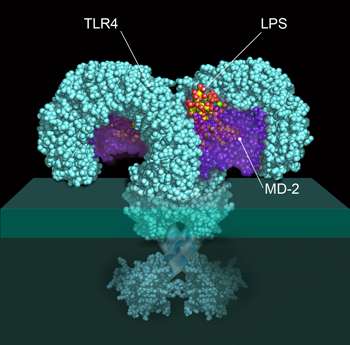A group of Slovenian researchers have discovered how the receptor of the immune system TLR4 (Toll-like receptor 4) works in rheumatoid arthritis. The receptor plays an important role in many diseases, including cancer.
Researchers from National Institute of Chemistry Slovenia have conducted a five-year long comprehensive study in which they have discovered how the TLR4 immune system receptor, which is involved in rheumatoid arthritis, works. TLR4 plays an important role in many diseases, including rheumatoid arthritis, atherosclerosis, neuropathic pain and even cancer. They have found that a common signal for all these diseases is oxidative stress. This discovery is a major achievement, since up until now the experts did not agree on its role. The study “Toll-like receptor 4 senses oxidative stress mediated by the oxidation of phospholipids in extracellular vesicles” was published in the scientific journal Science Signaling.

The molecular structure of Toll-like receptor 4 complex. Toll-like receptor 4 (TLR4) forms a complex with myeloid differentiation factor 2 (MD-2) and lippopolysaccharide (LPS). Image courtesy University of Texas at Austin
“We found that extracellular vesicles isolated from the plasma of patients with rheumatoid arthritis or secreted from cells subjected to oxidative stress contained oxidized phospholipids that stimulated cells expressing TLR4 in a manner dependent on its co-receptor MD-2.”
Our immune system is triggered when, for example, we get a bacterial infection. Sometimes however, the immune system can be triggered, even if the infection is not present. This is also what happens with the TLR4. The body is in fact behaving differently when the receptor is activated as a result of an infection or oxidative stress. During oxidative stress oxygen radicals are formed and these form oxidized lipids. In addition to this they trigger the activation of certain genes, which are involved in tissue regeneration.
Scientists are now trying to figure out what inhibits the activation of the receptor, which could open up new horizons in the treatment of these diseases.
By Jana Erjavec, PhD, BioSistemika LLC











